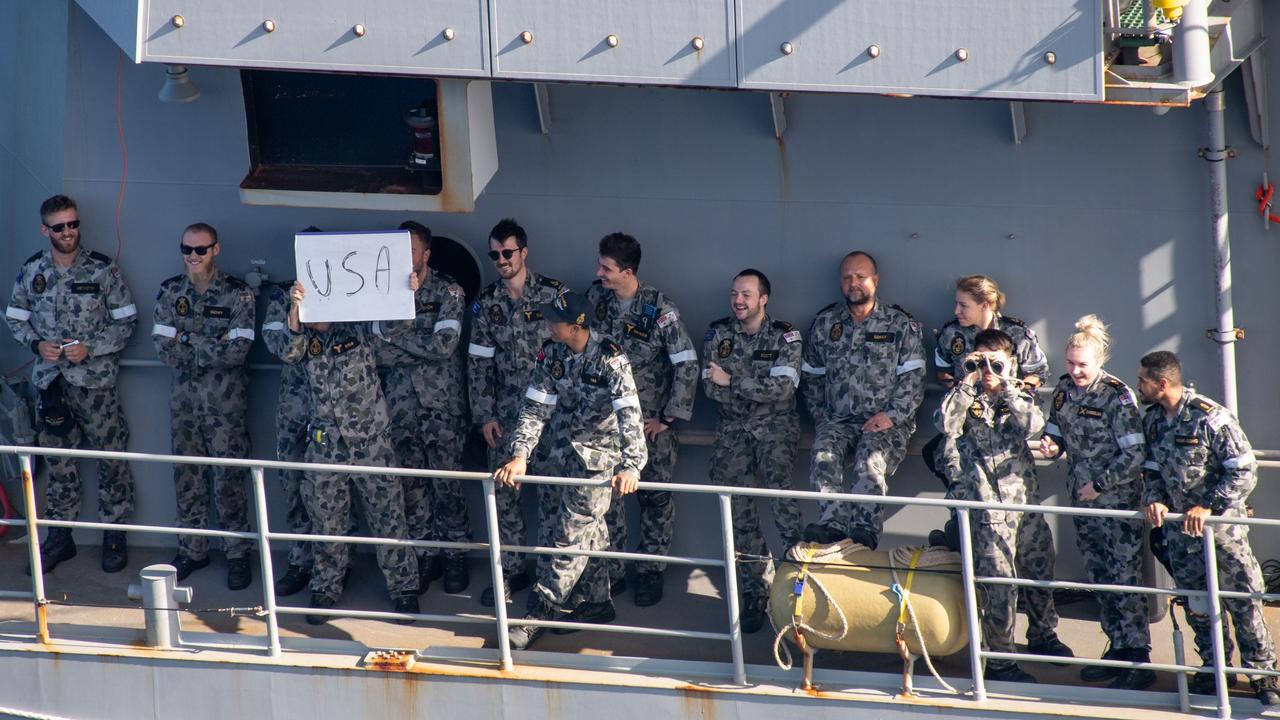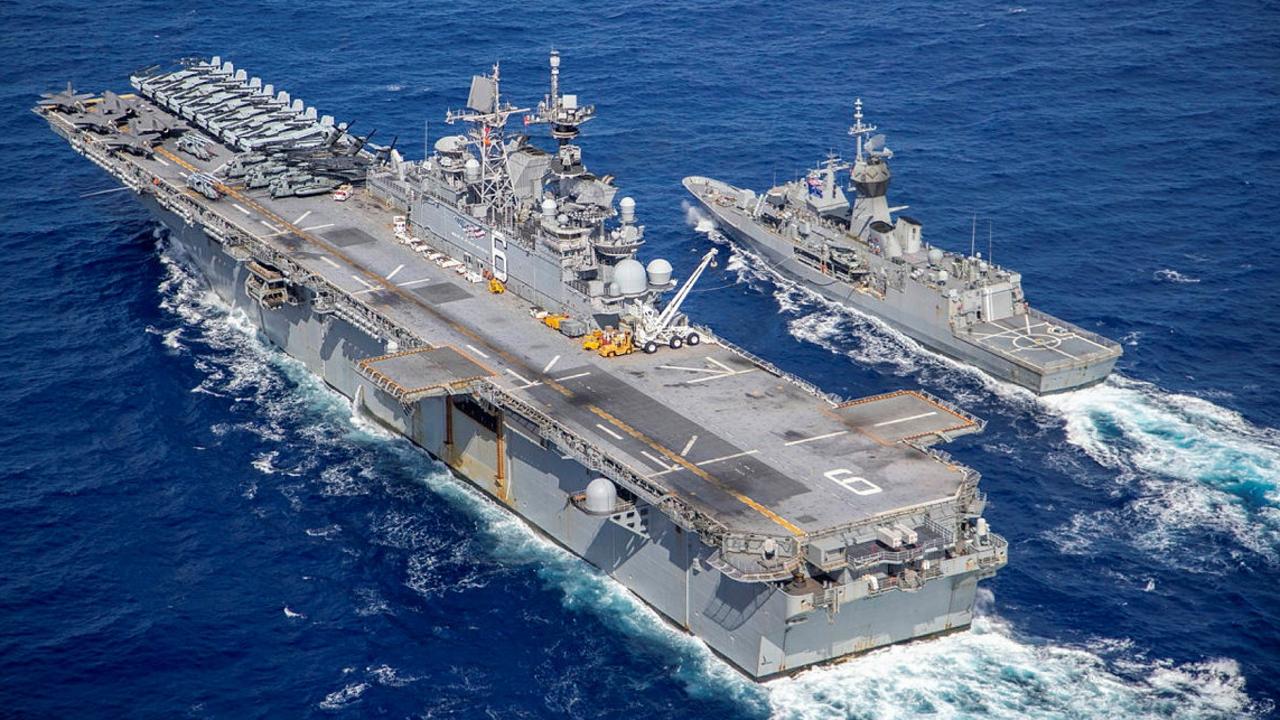US battleship commander tells of indescribable two hour experience captured on the Coral Sea
US battleship commander tells of indescribable history-making moment captured on the Coral Sea. SEE THE PHOTOS.
It was a brief moment of international camaraderie separated by both ocean and Covid-19 restrictions.
A group of smiling Royal Australian Navy sailors stand on the deck of the HMAS Ballarat, one of them holding up a handwritten sign that says ‘USA.’
One cradles a pair of binoculars as he peeks on board the USS America afloat in the Coral Sea, just off the coast of Queensland, where curious US Marines and sailors are waving back at the Aussies.
Others exchanged messages, phone numbers and social media account information in what has become the favourite moment of Exercise Talisman Sabre (TS21) for the US ship’s commanding officer, Captain Ken Ward.
“It was great. I don’t really know how to describe it,” he said.

“My sailors and the Australians got to enjoy each other in some fashion.
“We’ve done a lot of great training and have done some amazing stuff with our other partner nations, but that will go down with one of my favourite moments.”
The interaction happened on Tuesday when the 118m-long HMAS Ballarat, an ANZAC-class frigate, pulled alongside the 257m-long US battleship to undergo a refuelling at sea as part of Australia’s largest biennial military training exercise with the US, which started July 14 and ends Saturday with different aspects held throughout the state.
Capt Ward said it marked the first time a US amphibious assault ship had ever refuelled an allied nation’s vessel, a strategically important capability for both countries.
It also afforded the opportunity for some of the ships 2500 crew members to connect with their first Australians, albeit from a distance.

It is the closest interaction the US Marines, from the 31st Marine Expeditionary Unit, and sailors sitting on ships off the coast will have with Aussies during TS21, thanks to the coronavirus pandemic.
The crew members on board the US, Canadian, Japanese and South Korean navy vessels in this year’s maritime component of the mock war-games are not permitted to come ashore this year because of the pandemic and Australia’s mandatory 14-day quarantine restrictions.
Any of their fellow foreign military personnel partaking in the land component completed quarantine before the exercise began.
Capt Ward, 47, who has visited Australia before thanks to being on his fourth Exercise Talisman Sabre since 2007, said the men and women on board the USS America were disappointed about not being able to disembark, so relished the chance to have the short interaction with the RAN crew, with many exchanging messages on large signs.
“To say the sailors are disappointed to not go to Australia would be an understatement,” he said via satellite phone from the ship.

“It was a very naturally occurring event when the sailors came out … The upper decks were crowded with sailors … I thought it was awesome.
“It was a great demonstration, especially for the sailors and marines, who are not having the pleasure of going ashore and meeting Australians.”
Capt Ward said the improved interoperability between Australia and the US over the years was evident when the USS America smoothly filled the HMAS Ballarat with 400,000 litres of fuel.
“It was the first US ship of this type to conduct a fuelling evolution with an allied warship,” he said.
“I was just talking to the crew about this … to watch us operate with Ballarat … you would have thought we had done it 30 times in the past month,” he said.
Capt Ward said it was significant milestone as, although other ships like the USS Wasp, an aircraft carrier involved in TS19, had the capability to refuel other ships, they rarely did so as most had no extra fuel to spare because of their different functions.

“America has quite a bit more fuel and a lot more ammunition than the previous ships of similar build, so for us it’s not just about being a fortress,” he said.
“We have the ability to help sustain our partners and allies at sea.”
A major advantage of being able to refuel ships at sea was the time it saved on pulling in and out of a port.
“Not having to pull into port to resupply is important,” Capt Ward said.
“One of the hardest things to get is fuel.
“To be able to do that for one warship to another warship is an incredible capability.”
Capt Ward said, in line with tradition, each vessel played a song over their public announcement system as they split apart following the two hours of refuelling.
While the HMAS Ballarat blased ‘Thunderstruck’ by AC/DC, Lieutenant Commander Rob Wright, a RAN exchange officer on board the USS America chose to play Powderfinger’s ‘(Baby I’ve Got You) On My Mind.”
“It seemed appropriate,” he said.
Capt Ward said the successful refuelling and the crew interaction was “everything.”
“To me, it is everything that this exercise is about in a nutshell,” he said.
“If you can capture this exercise in two hours (they are) the two hours I would choose”.

The final week of TS21’s fictitious war scenario culminates with the amphibious phase, where combined forces from Australia, the US, Canada, Japan, the Republic of Korea, New Zealand and the UK move from land to sea.
Most of this week’s action, which has involved 20 ships and 60 aircraft, has been concentrated around the Bowen and Ingham areas and will feature air operations, beach-landings, armoured vehicles, and urban operations.
Commander Deployable Joint Force Headquarters, Australian Army Major General Jake Ellwood, said the amphibious phase includes complex joint force manoeuvres.
“This is the culminating activity we’ve been working towards throughout the year,” he said.
“It’s the final test of our ability to operate as a joint force in a contested environment across land, sea, air, space and cyber.”



